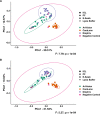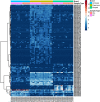Molecular and microbiological evidence of bacterial contamination of intraocular lenses commonly used in canine cataract surgery
- PMID: 36409704
- PMCID: PMC9678303
- DOI: 10.1371/journal.pone.0277753
Molecular and microbiological evidence of bacterial contamination of intraocular lenses commonly used in canine cataract surgery
Abstract
Inflammatory outcomes, including toxic anterior segment syndrome (TASS) and infectious endophthalmitis, are potentially painful, blinding complications following cataract surgery. In an in vitro pilot study, commercially available, sterile foldable intraocular lenses (IOLs) used during routine canine cataract surgery, and their packaging fluid were surveyed for the presence of bacterial DNA and/or viable (cultivable) bacteria. Swabs from IOLs and packaging fluid from three different veterinary manufacturers and three different production lots/manufacturer were collected for 16S ribosomal ribonucleic acid (rRNA) sequencing. Packaging fluid samples were collected for aerobic/capnophilic bacterial culture. Culture yielded one isolate, identified as Staphylococcus epidermidis. 16S rRNA sequencing revealed distinct brand-specific bacterial DNA profiles, conserved between IOLs and packaging fluid of all production lots within each manufacturer. The dominant taxonomy differentiating each manufacturer was annotated as Staphylococcus sp, and was a 100% match to S. epidermidis. Distinct mixtures of bacterial DNA are present and consistent in IOLs and packaging fluid depending on the manufacturer, and Staphylococcus is the dominant contributor to the bacterial DNA detected. Caralens products had a significantly lower amount of Staphylococcus spp. compared to Anvision and Dioptrix products.
Copyright: © 2022 Dowler et al. This is an open access article distributed under the terms of the Creative Commons Attribution License, which permits unrestricted use, distribution, and reproduction in any medium, provided the original author and source are credited.
Conflict of interest statement
The authors have declared no competing interests exist.
Figures



Similar articles
-
Ophthalmic viscoelastics commonly used in cataract surgery: A microbiota investigation.Vet Ophthalmol. 2023 Jul;26(4):306-314. doi: 10.1111/vop.13068. Epub 2023 Feb 11. Vet Ophthalmol. 2023. PMID: 36772992
-
Adherence of ocular isolates of staphylococcus epidermidis to ACRYSOF intraocular lenses. A scanning electron microscopy and molecular biology study.Ophthalmology. 2000 Dec;107(12):2162-6. doi: 10.1016/s0161-6420(00)00408-5. Ophthalmology. 2000. PMID: 11097589
-
Heparin and heparin-surface-modification reduce Staphylococcus epidermidis adhesion to intraocular lenses.Int Ophthalmol. 1997;21(2):71-4. doi: 10.1023/a:1005835013581. Int Ophthalmol. 1997. PMID: 9405987
-
[Intraocular lens and cataract surgery: comparison between bacterial adhesion and risk of postoperative endophthalmitis according to intraocular lens biomaterial].J Fr Ophtalmol. 2009 Sep;32(7):515-28. doi: 10.1016/j.jfo.2009.04.026. Epub 2009 Jun 17. J Fr Ophtalmol. 2009. PMID: 19539399 Review. French.
-
[Postoperative opacification of posterior chamber intraocular lenses - a review].Klin Monbl Augenheilkd. 2001 Sep;218(9):586-94. doi: 10.1055/s-2001-17635. Klin Monbl Augenheilkd. 2001. PMID: 11590465 Review. German.
References
Publication types
MeSH terms
Substances
Grants and funding
LinkOut - more resources
Full Text Sources
Medical
Miscellaneous

